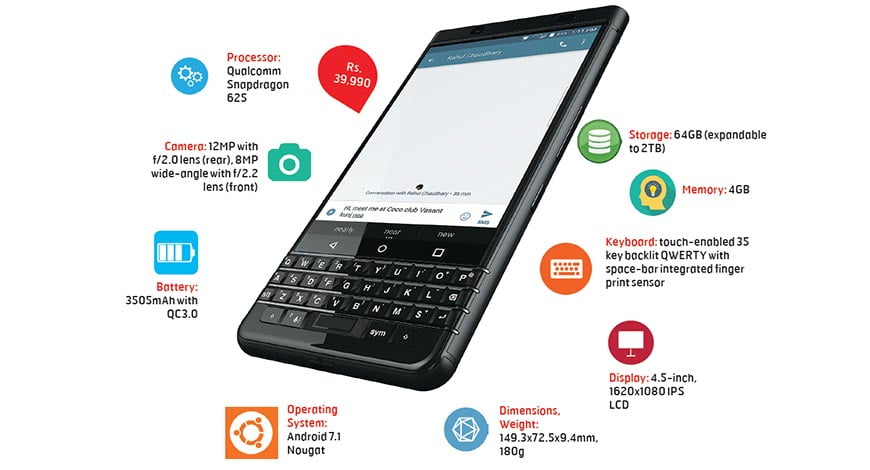

Over the past few years BlackBerry has launched a number of devices in a variety of form factors — the Passport, the Priv and the DTEK50 — in a bid to grasp at the straws of relevance, and the KEYone is the latest attempt from the once-ubiquitous Canadian brand to reclaim some of its lost glory. With the company’s products now made by other firms — Optiemus Infracom in the case of India, TCL elsewhere in the world — the KEYone is still very much a ‘berry at heart that will appeal to the core (but fast declining) band of loyalists. A big part of that appeal is the design, which returns to its roots with the signature 35-key keyboard below the screen, and it’s clear this keyboard benefits from the experience from all those BlackBerrys in the past. Despite being a bit squashed compared to one on the Bold, the keyboard has all the tactile feedback I remember from the best BB keyboards, once you get your grip sorted out on this rather tall device. The keyboard surface itself is touch sensitive, so you can use it like a trackpad when navigating around or selecting text, and in a clever move, the fingerprint sensor is embedded into the spacebar. You can even assign shortcuts to each letter key to open an app, dial a contact or trigger an action within system apps, and coupled with the Convenience key on the right edge, you get a number of handy shortcuts to quickly get stuff done. Using this keyboard over the better part of two weeks got me thinking about physical keyboards on phones, and try as I did, touchscreen keyboards are simply more efficient, more versatile and downright faster. They’re there when you need them, and go away when you don’t, giving you a bigger screen in the bargain. On the KEYone, you get a sharp 4.5-inch display with a squatter 3:2 aspect ratio to accommodate the keyboard, which works well for productivity apps where the keyboard is a necessity but leaves you with a significantly smaller screen (for phones equally as tall) when you want to watch a video or play a game.
BlackBerry’s Android efforts atop Android 7.1, which include a bunch of productivity and security-oriented apps and features, are an exercise in restraint, something more brands could look to emulate. The DTEK app does a competent job of tracking app permissions and the security status of your device, and deserves a special mention. The finely tuned software runs swimmingly on the mid-range hardware — the now-dated Snapdragon 625 chip with 4GB of memory and 64GB of expandable storage — and the battery lasts a full day of heavy use, though to be fair, you’re hamstrung by what you do on the device since the screen doesn’t really lend itself to gaming or video streaming. The camera works well in well-lit daytime shots, but was wildly inconsistent and slow in less than ideal lighting.
All said and done, expecting the average consumer to pay forty grand for the KEYone might be bit much, and anyone shopping for flagship looks, power or cameras would just rather spend their money on something from Samsung, LG or OnePlus. The niche to which it will appeal — a small section of corporates still hanging on to their Passports and Privs from yore, or those who value software security above all other reasonable demands from a phone — may bite, but that’s about it.
Disclaimer: The views expressed in the article above are those of the authors’ and do not necessarily represent or reflect the views of this publishing house. Unless otherwise noted, the author is writing in his/her personal capacity. They are not intended and should not be thought to represent official ideas, attitudes, or policies of any agency or institution.
[“Source-businessworld”]

